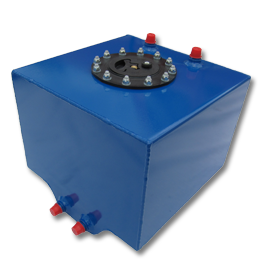
Gasoline vapors are highly flammable. It burn violently and can cause serious
injuries. Do not smoke near gasoline or when refueling. Keep sparks and flames
away from gasoline. Open the fuel cell lid slowly and wait for the pressure to
release before refueling. If you need a new fuel cell lid, get the right type
so it will fit properly. Fuel cell and all gasoline containers should be kept
well ventilated.

1. Mount the fuel cell according to the requirements of your racing classification
or sanctioning body, secure properly to the floor frame or chassis to prevent
shifting. Some requirements describe a size of mounting straps.
2. Fuel cells should always have good solid floor support under the cell for the
weight of the fuel. You must have support straps all around the cell. The top,
bottom, and sides must have the proper support. The tabs on aluminum cells are
for locating only.
3. Removal of any sharp metal edges from the area around the fuel cell is
recommended to prevent penetration of the fuel cell upon impact.
ALL FUEL CELLS MUST BE VENTILATED PROPERLY.
4. Attach a ground wire from cap flange to the vehicles frame.
5. Prior to use, flush the fuel cell with the fuel you will be using.

6. If your fuel cell has a sending unit, connect the center terminal
to the terminal on the back of the gauge marked "S". Connect the
outside terminal or screw to a ground near the fuel cell.
If your fuel cell has a sending unit, it is for a 0-90 ohm gauge.
(0 ohms = EMPTY | 90 ohms = FULL)
Sending units work with most GM factory gauges with 0-90 ohms. The center
post wires directly to the gauge and you must ground the sending unit from one
of the outside bolts of the sending unit to your frame. Always make sure your
fuel cell is properly grounded and vented.
7. Routinely check the fittings & cap ring for leaks and tighten as needed.
All AN fittings need to be tightened to 15 pounds of torque.

8. Due to the nature of the material and construction of your fuel cell, some
sagging may occur. This is a normal occurance and does not impact the performance
of your cell.
9. Fuel cell comes supplied with a vent fitting and must be completely open to
breathe properly. It is recommended that a vent hose is ran off the vent fitting
6" to 12" above the fuel cell, make one or two loops in the hose and run it down
the floor and outside the vehicle. A vented fuel cap is not a sufficient standalone
vent for the fuel cell.
10. Always run a high quality fuel filter.

11. Fuel cells are not street legal or D.O.T. approved.
12. When a vehicle abruptly changes directions, safety foams helps to reduce fuel surge
or fuel sloshing inside the fuel cell which creates a baffle effect.
13. When a vehicle takes sudden impact, safety foam inside the fuel cell helps to reduce
it's impact energy, thus reducing the risk of the fuel cell rupturing.
14. Safety foam will expand when it comes into contact with fuel. To function
properly, the fuel cell should have no more than 75% of it's volume filled with
safety foam.
15.Alcohol, Methanol, and Ethanol fuels will work with our safety foam, although
the water content in these fuels may cause foam to deteriorate at a faster rate
than normal.

16. Use of fuel additives may also increase safety foam deterioration rate.
17. It is recommended that you replace your fuel cells safety foam once per year.
__________________________________________________________________________________
WARNING
Auto racing is hazardous. The user of this product assumes all risk in connection with
it use. This product is sold without warrant, express or implied. No warranty or
representation is made as to this products ability to prevent injury or death.









